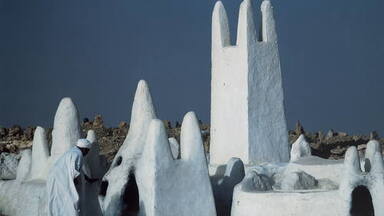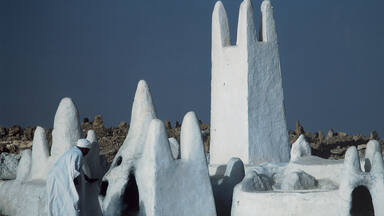M'Zab Valley
M'Zab Valley
A traditional human habitat, created in the 10th century by the Ibadites around their five ksour (fortified cities), has been preserved intact in the M’Zab valley. Simple, functional and perfectly adapted to the environment, the architecture of M’Zab was designed for community living, while respecting the structure of the family. It is a source of inspiration for today’s urban planners.
Description is available under license CC-BY-SA IGO 3.0
Vallée du M'Zab
Le paysage de la vallée du M’Zab, créé au Xe siècle par les Ibadites autour de leurs cinq ksour, ou villages fortifiés, semble être resté intact. Simple, fonctionnelle et parfaitement adaptée à l’environnement, l’architecture du M’Zab a été conçue pour la vie en communauté, tout en respectant les structures familiales. C’est une source d’inspiration pour les urbanistes d’aujourd’hui.
Description is available under license CC-BY-SA IGO 3.0
وادي مزاب
يبدو منظر وادي مزاب الذي تأسس في القرن العاشرعلى يد الأباظيين حول قصورهم الخمس أو قراهم المعزّزة وكأنه لا يزال على حاله. وقد صُمّمت الهندسة المعمارية لمزاب، وهي بسيطة وعملية ومتكيّفة تماماً مع البيئة من حولها، للعيش في الجماعة مع احترام البنى العائلية. إنها مصدر وحي لعلماء التنظيم المدني اليوم.
source: UNESCO/CPE
Description is available under license CC-BY-SA IGO 3.0
姆扎卜山谷
这是一个传统的人类居住地,由伊巴底人(the Ibadites)于十世纪围绕五座城邦修建而成,完整保存在姆扎卜山谷中。姆扎卜建筑简朴、实用,完美地与环境融为了一体。姆扎卡的建筑结构是为群体居住而设计的,但同时也考虑到了家庭的结构,当今城市建筑的设计者可以此为借鉴。
source: UNESCO/CPE
Description is available under license CC-BY-SA IGO 3.0
Долина Мзаб
Традиционный район поселения мусульман-ибадитов, существующий с X в. вокруг пяти ксуров (укрепленных городов) в долине Мзаб, сохранился до нашего времени неизменным. Простая и функциональная, великолепно приспособленная к окружающей среде архитектура района Мзаб была предназначена для жизни общин, придерживающихся традиционной семейной структуры. Это - источник вдохновения и для современных градостроителей.
source: UNESCO/CPE
Description is available under license CC-BY-SA IGO 3.0
Valle del M’Zab
El paisaje del Valle del M’Zab, creado por los ibaditas en torno a cinco aldeas fortificadas (ksur), se conserva prácticamente intacto. Sencilla, funcional y perfectamente adaptada al entorno, su arquitectura fue diseñada para una vida en comunidad que respetase las estructuras familiares. El sitio constituye una fuente de inspiración para los urbanistas contemporáneos.
source: UNESCO/CPE
Description is available under license CC-BY-SA IGO 3.0
ムザブの谷
アルジェリア北部、首都アルジェの南約450km、サハラ砂漠の涸れ谷にある五つの街の建築群。異端視された「イスラム清教徒」ムサブ人が、長い流浪の末、11世紀始めカルダイアを中心とする五つの街を築き、定住した。頑強な防護壁に守られた市街には、先端が王冠状の簡素なモスクや家屋が密集し、そのキュビズム的な建築造形とユニークな景観を誇る都市計画は、ル・コルビュジエなど現代の多くの建築家を魅了している。source: NFUAJ
De M'Zab vallei
In de M'Zab vallei is een traditionele leefomgeving bewaard en intact gebleven. In de 10e eeuw richten de Ibadieten deze habitat op rond hun vijf ksour (versterkte steden). De architectuur van M'Zab was eenvoudig, functioneel en aangepast aan de omgeving. Elk huis bestond uit een standaard ruimte waarmee men aangaf gelijk te zijn aan elkaar. De familiestructuur stond hoog in het vaandel. Hiermee hoopten de Ibadieten hun intimiteit en autonomie te behouden. M'Zab getuigt van een inheemse architectuur die ongekunsteld was, maar perfect aansloot op de omgeving. Om deze reden is M'Zab vandaag de dag nog steeds een inspiratiebron voor architecten en stedenplanners.
Source: unesco.nl
Outstanding Universal Value
Brief synthesis
Located 600 km south of Algiers, in the heart of the Sahara Desert, the five ksour (fortified villages) of the M'Zab Valley form an extraordinarily homogenous ensemble constituting, in the desert, the mark of a sedentary and urban civilization possessing an original culture that has, through its own merit, preserved its cohesion throughout the centuries. Comprised of ksour and palm groves of El-Atteuf, Bounoura, Melika, Ghardaïa and Beni-Isguen (founded between 1012 and 1350), the M'Zab Valley has conserved practically the same way of life and the same building techniques since the 11th century, ordered as much by a specific social and cultural context, as by the need for adaptation to a hostile environment, the choice of which responded to a historic need for withdrawal and a defensive imperative. Each of these miniature citadels, surrounded by walls, is dominated by a mosque, the minaret of which functions as a watchtower. The mosque is conceived as a fortress, the last bastion of resistance in the event of a siege, and comprises an arsenal and a grain store. Around this building, which is essential for communal life, are houses built in concentric circles up to the ramparts. Each house constitutes a cubic cell of standard type, illustrating an egalitarian society founded on the respect for the family structure, aiming at the preservation of its intimacy and autonomy. At the beginning of the first millennium, the Ibadis created in the M'Zab, with local materials, a vernacular architecture which, with its perfect adaptation to the environment and the simplicity of its forms, is an example and an influence for contemporary architecture and town-planning.
Criterion (ii): The anthropic ensembles of the M'Zab Valley bear witness, by their exceedingly original architecture dating from the beginning of the 11th century and by their rigour and organization, to an outstanding and original occupation model for human settlements of the cultural area of central Sahara. This model settlement has exercised considerable influence for nearly a millennium on Arab architecture and town-planning, including architects and town-planners of the 20th century, from Le Corbusier to Fernand Pouillon and André Raverau.
Criterion (iii): The three elements constituting the urban ensembles and settlements of the M'Zab Valley: ksar, cemetary, and palm grove with its summer citadel, are an exceptional testimony of the Ibadis culture at its height and the egalitarian principle that was meticulously applied by the Mozabite society.
Criterion (v): The elements constituting the M'Zab Valley are an outstanding example of a traditional human settlement, representative of the Ibadis culture that, through the ingenious system for the capture and distribution of water and the creation of palm groves, demonstrates the extremely efficient human interaction with a semi-desert environment.
Integrity (2009)
The boundaries of the site are well defined and include all the attributes of the property. Restoration operations of historical cultural and cult monuments (mausoleums and mosques), the defensive system (surround, watchtowers, ramparts and house ramparts) and the hydraulic system, contribute towards the maintenance of integrity. Despite the effects of pressure from town development and minor damages caused by occasional flooding, the attributes of the property are not threatened and the M'Zab Valley property still retains intact its conditions of integrity.
Authenticity (2009)
The authenticity of the site can be attributed to its configuration, divided into sections, the layout and traditional constructions of the ksour, particularly in the intra muros areas. The maintenance of traditional functions in these areas has strengthened the viability of the property and contributed towards the maintenance of its integrity.
Protection and management requirements (2009)
The management and protection of the M'Zab Valley property are entrusted to the Office for the Protection and Promotion of the M'Zab Valley (OPPVM), the main tasks of which concern the enforcement of legislation concerning the protection of cultural heritage, the constitution of a data bank of the monuments and sites and promotion, research and training in the fields of traditional building and artisanal crafts.
In conformity with these tasks, and in the framework of Law 98/04 concerning the protection of cultural heritage, the M'Zab Valley has been promoted to the Safeguarded Sector, with provisions in conformity with the maintenance of its integrity. The M'Zab Valley has experienced a much accelerated urban and demographic growth since the beginning of the 1980s due to its strategic location between the north and south of the country. The development of a safeguarding plan would enable the safeguarding and valorisation of the cultural heritage of the Valley notably through the control of urban growth in the vicinity of the palm groves, flood areas as well as the constitutive elements of the natural landscape.




